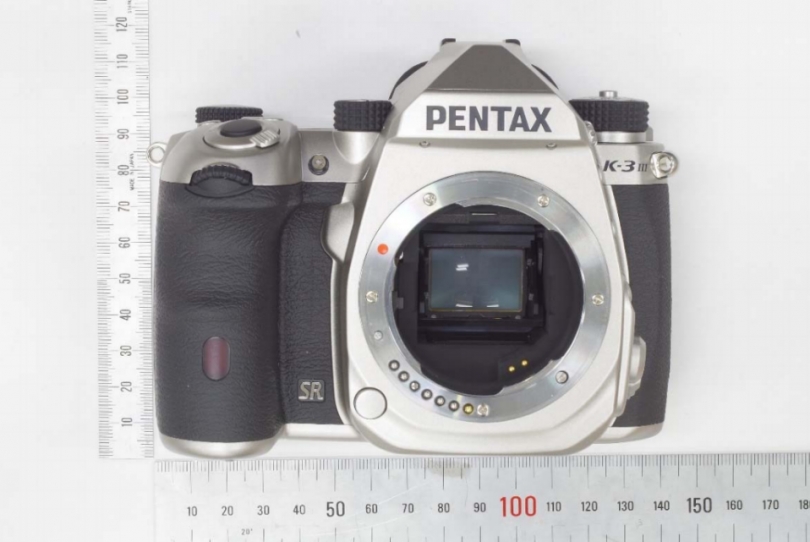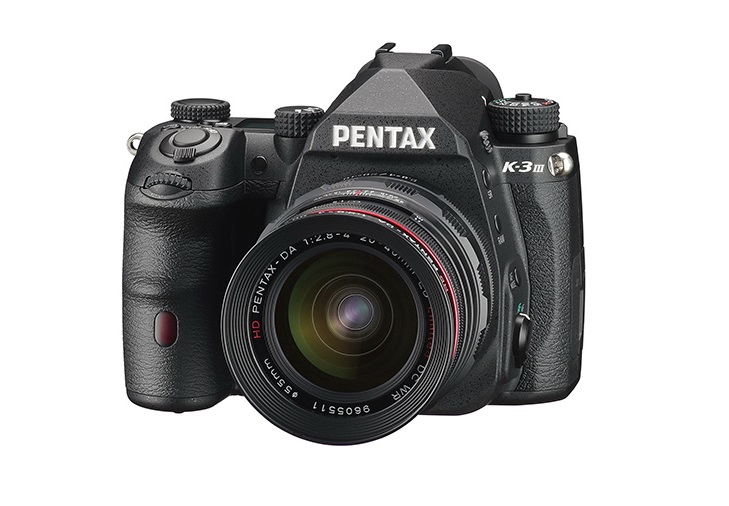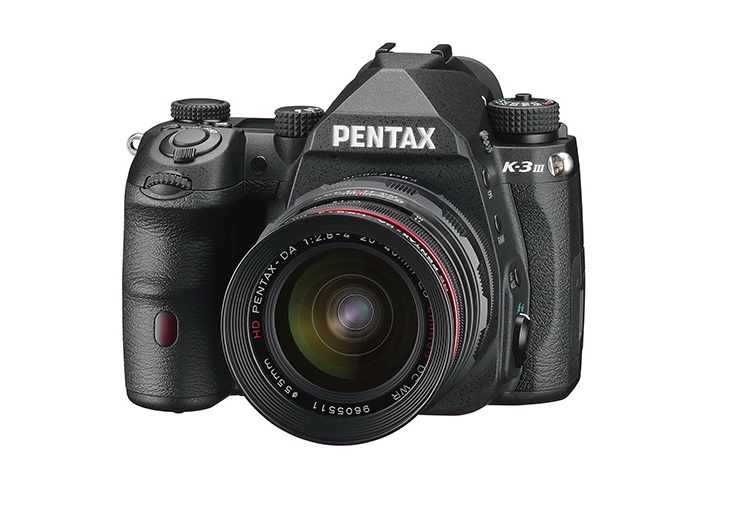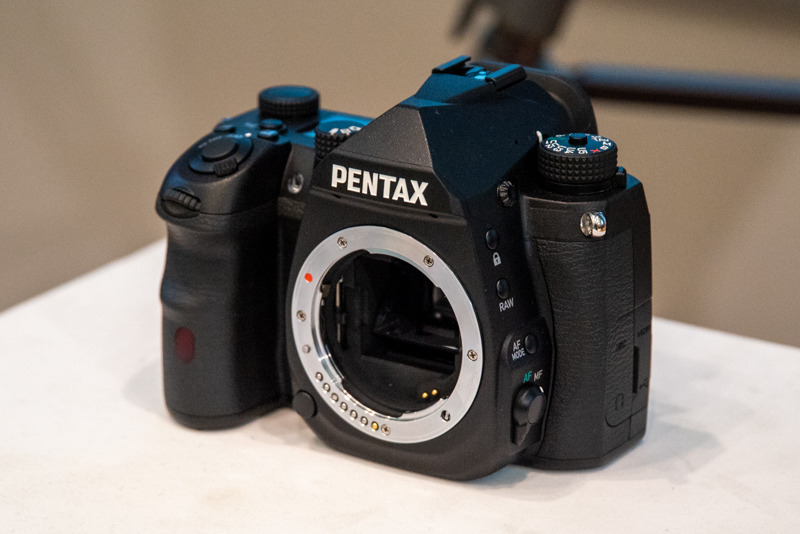
$(document). ready(function() { SampleGalleryStripV2({"galleryId":"3933030194","isMobile":false}) }) The Pentax K-3 Mark III is Ricoh's latest high-end APS-C DSLR. It's built around a 26MP BSI-CMOS sensor and has been redesigned from the ground up to become, on paper, the most capable, most usable K-mount camera ever made.
Jump to:
What's new| How it compares | Body and handling | Initial impressions | Specifications
Although it shares much of its styling with the K-3 II, launched in 2015, the third iteration has been significantly redesigned and re-thought to offer improvements across the board. From the viewfinder and the sensor right down to the shutter button, it's essentially an all-new DSLR.
Key specifications
25. 7MP BSI-CMOS sensor
SAFOX 13 AF module with 101 AF points (25 cross-type)
5-axis in-body stabilization rated to 5. 5EV
Weather-sealed magnesium alloy construction
Viewfinder with 1. 05x magnification
Revised three-dial control system
8-direction AF joystick and touchscreen for AF positioning
UHD 4K movie capture at up to 30p
In addition, the K-3 III has all the usual modes making clever use of the image stabilization system, including Anti-Aliasing Filter Simulation and the multi-shot Pixel Shift Resolution mode that shoots and combines four offset images to cancel out the Bayer pattern and remove the need for sharpness-sapping demosaicing.
The K-3 III will be available from late April in a choice of black or silver with a recommended price of $2000. A weather-sealed D-BG8 battery grip with matched controls will also be available. A kit combining the body and grip (along with a strap and additional battery) is priced at $2300.
What's new. . .
Sensor
At the heart of the K-3 III is a new BSI CMOS APS-C sensor. Ricoh describes it as a 25MP chip, but the cameras resolution is actually 25. 7MP, raising the possibility that it's related to the one using in Fujifilm's X-T4 (albeit with a more conventional color filter array and no pixels masked for phase detection).
Either way, the sensor has no anti-aliasing filter and is capable of 14-bit readout at up to 12 fps. Ricoh says the new sensor has better high ISO noise characteristics than the 24MP chip in the KP and that this combines with improved processing power from its PRIME V processor and 'Accelerators Unit II' pre-processor to give better detail retention and noise reduction in low-light conditions. Though this could well mean noise reduction applied in to Raw data, as it did with the K-1 Mark II.
The camera can shoot at up to ISO 1,600,000.
Viewfinder
One of the most significant revisions in the K-3 III is an all-new viewfinder. Building on a Pentax tradition of large, prism-type viewfinders, the K-3 III's viewfinder is a pentaprism offering an impressive 1. 05x magnification.
Ricoh says the K-3 III's viewfinder has a 10% improvement in brightness over the Mark II
Viewfinder magnification figures are usually calculated with 50mm lenses, regardless of sensor size, so some of that high figure comes from the apparent magnification of the camera's APS-C sensor. But, even taking this into account, it would be equivalent to a 0. 68x magnification finder on full-frame, making it only a fraction smaller than the 0. 70x finder in the Pentax K-1 models. That's small by the standards of many mirrorless cameras, in which viewfinder size isn't dependent on the viewing angle of the sensor, but is the largest ever fitted to an APS-C DSLR.
More than just the size, the new finder has been designed using a transparent display panel in the viewing path, rather than having the display of a separate panel projected into the finder, as was the case in previous K-3s. Ricoh says this change provides a 10% improvement in brightness over the Mark II. It also allows more flexibility in display customization.
New Autofocus module
Ricoh has developed a completely new AF module for the K-3 III. The Safox 13 has 101 AF points, 25 of which are cross-type. 41 of the AF points can be manually selected and the centermost nine points can focus at down to -4EV when paired with lenses that are F2. 8 or brighter.
The optics in front of the lens module expand the coverage of AF points to be 20% wider in the frame than the Safox 11 module in the K-3 II.
On top of this, the camera's continuous AF system has been completely reworked. The K-3 II uses a 307k-pixel RGB+IR metering sensor that provides the AF system with a higher-resolution view of the subject for subject recognition and tracking. A review of the predictive AF algorithms and the deep-learning-trained ability to recognize faces or subjects such as birds promises improved AF-C performance in a range of situations.
Improved in-body stabilization
In-body stabilization is no longer the rarity it was when Pentax first introduced its Shake Reduction system, and the K-3 III's system has been re-worked to keep up with the competition.
The five-axis 'SR II' IS system is rated at 5. 5EV, using CIPA standard testing, which is a 1. 0EV improvement over the rated performance of the K-3 II, and 0. 5EV more than the K-1 Mark II. A dedicated 'SR' button lets you switch the camera between the default Auto mode, off, or 'Panning' mode, which lets you adjust the response, if the Auto mode isn't correctly detecting slow, intentional panning movements.
Shutter mechanism
As with all the other major components of the camera, the K-3 III's shutter mechanism has been completely reworked. It uses a coreless motor to drive both its shutter and mirror mechanisms, improving response times. The mirror mechanism has been made lighter, to reduce inertia.
The redesign means the mirror settles quicker, giving shorter viewfinder blackout times and giving the AF and metering systems more time to assess the scene between shots. This helps support the camera's ability to shoot at up to 12 fps (11 fps with continuous autofocus).
The shutter unit is rated to withstand 300,000 releases, and the adoption of a leaf switch mechanism under the shutter button helps give a smoother response as well as increased durability to match.
4K capture
The K-3 III becomes the first K-mount camera to offer 4K video capture. It can shoot UHD 4K at up to 30p and includes touchscreen control to avoid adding noise during recording.
Ricoh says the new IS system is quiet enough to be used during video capture, meaning the K-3 III is able to offer 3-axis (Roll, pitch and yaw) correction using mechanical stabilization, rather than the digital IS used in previous models.
Return to index
How it compares. . .
It's fair to say that the APS-C DSLR market is not what it once was. So we've tried to include meaningful reference points, however you choose to look at the K-3 III.
If you're in the market for an enthusiast-level APS-C camera, Fujifilm's X-T4 is the one to beat. If you're not set on an APS-C sensor then you can get the very capable Nikon Z6 II for a similar amount of money. If it has to be a DSLR, then Nikon's D500 remains an impressive contender, but if you have K-mount lenses you need to use, the K-1 Mark II is also worth a look.
Pentax K-3 III
Fujifilm X-T4
Nikon Z6 II
Nikon D500
Pentax K-1 II
MSRP (body)
$1999
$1699
$1995
$2000
$1999
Sensor res.
26MP
26MP
24MP
21MP
36MP
Sensor size
APS-C
APS-C
Full-frame
APS-C
Full-frame
In-body image stabilization
5. 5 stops
6. 5 stops
5. 0 stops
Lens only
5. 0 stops
Autofocus system
Secondary PDAF
(101 pts)
On-sensor
On-sensor
Secondary PDAF
(151 pts)
Secondary
PDAF
(33 pts)
LCD type
Fixed
Fully articulating
Tilting
Tilting
Flexible-tilt
LCD size/res
3. 2" 1. 6M-dot
3. 2" 2. 1M-dot
3. 2" 2. 1M-dot
3. 2" 2. 1M-dot
3. 2" 1. 0M dots
Viewfinder res / mag
(equiv. )
Optical, 0. 68x (equiv. )
3. 69M-dot
0. 77x
3. 69M-dot
0. 8x
Optical, 0. 67x (equiv. )
Optical
0. 70x
Burst speed
11 fps (12 fps with AF locked)
15 fps / 20 fps mech/
e-shutter
14 fps
10 fps
4. 4 fps
Storage
1 UHS-II SD;
1 UHS-I SD
2 UHS-II SD
1 UHS-II SD;
1 CFexpress Type B / XQD
1 UHS-II SD;
1 XQD
2 UHS-I SD
Video
(internal)
4K/30p
8-bit
4K/30p (4K/60p w/ 1. 18x crop)
10-bit
4K/30p
(4K/60p w/ 1. 5x crop)
8-bit
4K/30p
(1. 5x crop)
8-bit
Full HD / 30p
8-bit
Mic / headphone socket
Yes / Yes
Yes / Yes (with included adapter)
Yes / Yes
Yes / Yes
Yes / Yes
Battery life
800 shots
500 shots
410 shots
1240 shots
670 shots
Weight
820g (28. 9oz)
607g (21. 4oz)
705g (24. 9oz)
860g (30. 3oz)
1010g (35. 6oz)
Making a pick from such a diverse list is, of course, challenging. The K-1 II will offer better image quality if you mount full-frame lenses (and what are likely to be pretty competitive, albeit ~15MP, images when cropped to APS-C), but it uses an older AF system, can't shoot as fast, is heavier and can't shoot 4K video. The full-frame Nikon will again offer better image quality and has a very capable AF system. The Fujifilm can shoot faster and has a much better video spec, but like the Nikon can't offer the longer battery life or optical viewfinder of a DSLR.
Essentially, it's impossible to say whether the K-3 III makes sense for you without knowing why you're considering it. However, what should be clear is that it's a well-specced machine even compared with the latest mirrorless rivals, which means it's a fair step forward from older APS-C Pentaxes.
Return to index
Body and handling
The K-3 III iterates on the ergonomics of the exiting K-3 models, which we've frequently praised. We're pleased to be able to say that the K-3 III doesn't diverge too much from this pattern: the magnesium alloy construction maintains the impressively dense and solid feeling that its predecessors conveyed. And, of course, it offers the extensive weather-sealing Pentax cameras have become known for.
The handgrip and dial position will be immediately familiar to Pentax shooters: it's a camera that feels immediately comfortable in the hand.
Smart function button
The K-3 III iterates on the 'Function Dial' concept of the K-1 II. This adds an extra dial to the camera's top plate, just forward of its rear command dial, which can be used to quickly access camera functions beyond the basic exposure controls of the two main command dials.
Rather than having a fourth dial to dictate the action of the Function Dial, the K-3 III has a button that cycles the dial's function between the options custom assigned to it. You can select up to five options from a list of 22, to give you quick access to settings such as ISO, exposure comp, AA Filter Simulation, white balance or crop mode.
It's even possible to customize which of the sub-options of particular settings are assigned to the dial, giving quick access only to the functions you want to use.
Instead of a function dial, the K-3 III has a small control to the right of the viewfinder hump for switching between viewfinder photography, live view shooting and video mode.
Joystick
The K-3 III gains an 8-direction joystick, which allows rapid AF point selection by allowing diagonal movement. Pressing the joystick inwards resets the AF point to its central position.
Touchscreen
The K-3 III's rear panel is a large, 3. 2" 1. 62M-dot LCD. It's a fixed panel, offering no articulation or movement, but it's touch-sensitive in all the ways that make sense in a DSLR. In live view mode it can be used to position the AF point, position the AF point and focus, or position, acquire focus and fire the shutter. It can do similar things in movie mode and these settings can be defined separately.
The camera's menus have been redesigned to make them touch operable and you can make all the expected pinch-to-zoom and swipe-to-scroll movements that you might expect in image playback mode.
The K-3 III's viewfinder has an eye sensor that switching off the screen when you put your eye to the camera. The finder also protrudes further from the back of the camera than on its predecessor, reducing the risk of accidentally touching the rear screen with your nose.
Battery
The K-3 III uses the same D-LI90P battery as the K-1 Mark II. This is rated to deliver 800 shots per charge, per the CIPA standard test methods. As usual, these figures don't necessarily reflect how many shots you'll get (it's not uncommon to achieve double the rated figure, depending on how you shoot), but the ability to shoot without any display panels active gives the DSLR design a major advantage over mirrorless rivals.
The battery can be charged over the camera's USB-C socket. Sadly the K-3 III doesn't come with an external charger for its battery, it relies on a supplied USB wall adapter and cable.
Return to index
Initial impressions
The K-3 III gains an SR button. The exact function of all these buttons can be fine-tuned.
For transparency it should be made clear that, despite press releases, teasers and mockups dating back to at least September 2019, we've not had too much time with the K-3 Mark III, hence the lack of image samples.
However, the time we have spent, along with the details Ricoh has released make clear how much effort has gone into this camera. We also know that the Pentax system has a dedicated following who want to know about it, so we've tried to provide as much detail as is currently possible.
It's clear Ricoh's engineers have looked at every detail and asked 'what could be done to make this better?'
Alongside this announcement, there'll no doubt be plenty of YouTube videos ridiculing the idea of spending so much time and effort developing an enthusiast DSLR in what could be seen as the post-DSLR era. But that's not the way I see things. I'm no Shakespearean scholar: I come not to bury the K-3 III, but to praise it. In concept at least.
When we reviewed the Nikon D850, it struck me that it might be the pinnacle of DSLR design. In part because it was so good in so many ways but also because, with the exception of a few models for the pro-sport/photojournalism niche, it seemed unlikely that there'd be many contenders for its crown.
I can't yet say how well Ricoh has done in this regard, but it's clear that its engineers have looked at every detail of the K-3 II and asked 'what could be done to make this better?'
Ricoh has also developed a matching battery grip, the D-BG8. It features the same controls as the camera body. The second battery it adds can also be charged using the camera's USB port.
There's an argument that this is proof of Ricoh trying to produce the perfect buggy whip* when most other companies are looking at how to replace the internal combustion engine, but perhaps this only matters if you assume that every camera is trying to be the best camera for everyone. It may make sense for Ricoh to try to be the last company offering an up-to-date DSLR for those photographers who love the optical viewfinder experience.
The K-3 III's price can also look somewhat anachronistic. The Nikon D500 was launched for $2000 and Canon's EOS 7D Mark II for $1800, but a long time has passed since those cameras were released. It's no longer uncommon for full-frame cameras to be released at or below $2000 (including Ricoh's own very impressive Pentax K-1 models).
For some people it'll be better to have an improved DSLR for their K-mount lenses than to have yet another mirrorless option
But that still assumes that these other cameras would make appropriate substitutes for the K-3 III. If you've spent a decent chunk of your life and your income building up a set of good Pentax lenses, that may not be the case. For some people it'll be better to have an improved DSLR for their K-mount lenses than to have yet another mirrorless option that would still require a whole new set of lenses or risk a sub-optimal experience with adaptors.
Perhaps the only question that matters for the K-3 Mark III is: does it offer enough of an improvement to prompt existing Pentax owners to upgrade? We can't know for certain until we've tested it, but it's clear that Ricoh has done all it can to make it a 'yes', with promised improvements to just about every aspect of the camera. Maybe we've not yet seen the last great DSLR, after all.
Return to index
*An arguably flawed metaphor from Theodore Levitt's 1960 Harvard Business Review essay 'Marketing Myopia' which suggests that companies need to remember what customer need they address, rather than the specifics of how they currently address it.
. dpreview.com2021-3-31 01:00





